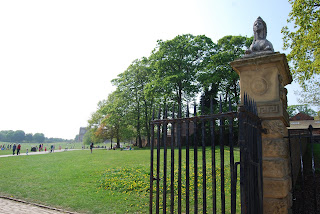The blue skies of the weekend had disappeared by the time we arrived at Oakwell and I was rather rueing the fact that I’d forgotten the cardinal rule of a good walker in the UK – always bring a waterproof with you. Sure enough the odd spot of rain turned into rain driven by a north easterly wind. Still at least I wasn’t being pursued by a bunch of Cavaliers (the Royalists) unlike the Parliamentarian (or Roundhead if you want) Lord Fairfax and his men on the 30th of June 1643 .
Oakwell Hall appears in Charlotte Bronte’s novel disguised as Fieldhead. She describes it like this:
If Fieldhead had few other merits as a building, it might at least be termed picturesque: its irregular architecture, and the grey and mossy colouring communicated by time, gave it a just claim to this epithet. The old latticed windows, the stone porch, the walls, the roof, the chimney-stacks, were rich in crayon touches and sepia lights and shades. The trees behind were fine, bold, and spreading; the cedar on the lawn in front was grand, and the granite urns on the garden wall, the fretted arch of the gateway, were, for an artist, as the very desire of the eye.
Charlotte Bronte (2009) Shirley. London
 |
| Oakwell Hall |
Its appearance hasn’t changed much since 1849 when Charlotte Warren Lane or Bloody Lane as it was known after the battle.
The walk taken from Battlefield Walks in Yorkshire led us away from Oakwell towards Adwalton. The directions indicated that we would have to walk along the side of the A650 but I hadn’t realised just how busy the road was going to be or that there was no path. Oddly a broad green verge offers a less secure sense of safety than a nice narrow tarmac pavement. Don't ask me why.
Most of the nobility in Yorkshire turned out for King Charles I during the English Civil War of the seventeenth century. York York London
The Royalist target was Bradford – a town without a wall. So it wasn’t a good place to hole up for a long siege. The Earl of Newcastle had an army of 10,000 men and he was determined that Bradford would fall.
Lord Fairfax set out to meet the Royalist army with 4,000 men. For some reason they were delayed on their journey and by the time they met with the Royalists, Newcastle
 |
| View of Adwalton Moor from Marker Four |
Once we achieved the ridge where the Earl of Newcastle lined his army up for battle I relaxed. There were no hurtling lorries to distract me from discovering more about Yorkshire and its history. Cavalry and infantry are now replaced by 1950s bungalows and red brick terraces. The moor itself is surrounded by roads and buildings but in 1643 the landscape was much more rural despite the open cast mining that took place nearby.
The Royalists, despite their advantages in positioning, men and guns very nearly lost the battle. Lord Fairfax made good use of his experienced musketeers who were able to make good use of hedges for cover. These days the only hand to hand combat takes place on Adwalton’s rugby pitch.
For a while it looked as though the Parliamentarians were going to win despite the heavy odds against them. However an attack by Royalist pikemen led by the intriguingly named Sir Posthumus Kirton resulted in a collapse of the centre of the Parliamentarian lines. In a short time the Roundheads were in full flight. Sir Thomas Fairfax (Lord Fairfax’s son) and his men were unable to retreat towards Bradford with the rest of his father’s army and fled down Warren Lane in the direction of Oakwell Hall.
 |
| Warren Lane where Thomas Fairfax and his men fled from Newcastle's Royalists. |
There are still warrens and plenty of rabbits lining Warren Lane today. There’s also an underpass going beneath the M62. Somehow or other I’d overlooked the sound of traffic during our walk and exploration of the stone markers outlining the events of 30th June 1643. There are four stone markers but we never did locate one of them- we found dog walkers, two piebald ponies and a pond though.
The Battle of Adwalton meant that the whole of Yorkshire was ripe for the taking. All that the Royalists had to do was to secure Hull
The Batts who lived at Oakwell Hall were Royalist sympathisers but it didn’t stop Newcastle Warren Lane , its line slightly shifted with the advent of the railways we made our way to Oakwell Hall’s café for a well deserved sandwich followed by a stroll around the herb garden.

